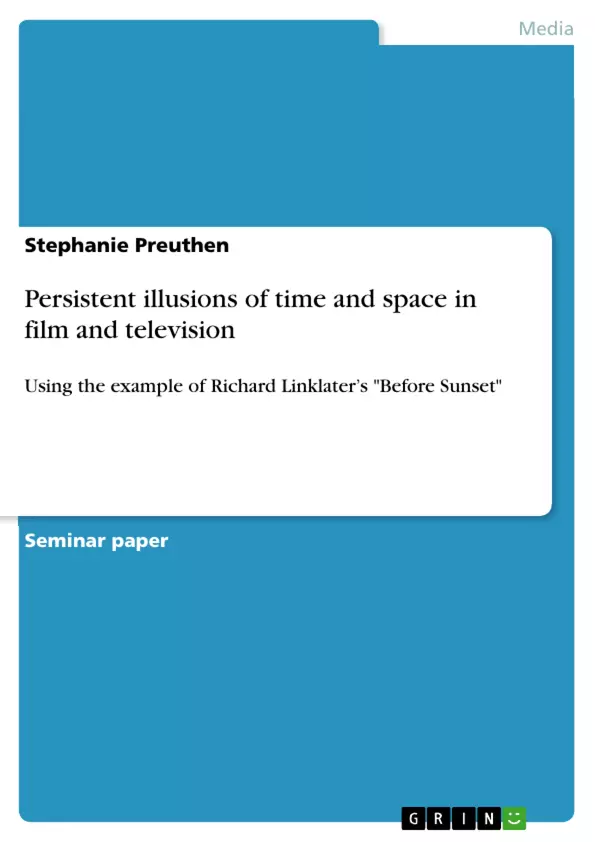In film and television production, most of the multiplicity of rendered effects are ultimate results of cleverly devised composition and camera techniques. To entertain in cinematic terms means to attract the viewer’s attention by affecting him at the very core of his being. Very personal and intimate feelings must be evoked to achieve such visual awareness and therefore producers and directors of television shows and feature films are utilizing the entire technology’s capacity. Most of the time, the usage of cinematic techniques comes along with heavy losses of such elements that are still realistic and original. Illusions of time and space are created and spectators are regularly deluded.
The main concern of this term paper is to provide the reader with an as broad as possible overview of the technological trends that occurred in the past centuries and are of fundamental importance for the creation of illusions. Specific attention will at this juncture be turned to the manipulation of space and time, as well as to the director’s intentions that were followed by it.
In the second part of the paper in hand, the established principles of media-theoretical terms will be transferred to Richard Linklater’s Before Sunset, a follow-up to the 1994’s success Before Sunrise. A film which consists of long-take tracking shots and evokes the illusion of realism in terms of time and space that are passed, which is why it is almost predestined for a closer analysis like this.
Inhaltsverzeichnis (Table of Contents)
- INTRODUCTION.
- THE THEORETICAL FRAME
- DEFINITIONS OF ILLUSION.
- FILM AND TELEVISION AS INSTITUTIONS OF ILLUSORY WORLDS
- TECHNICAL BASES FOR THE CREATION OF ILLUSIONS
- FILMIC ILLUSIONS OF TIME AND SPACE.
- MISE-EN-SCENE IN SPACE AND TIME.
- ILLUSIONS OF TIME
- SPATIAL ILLUSIONS.
- RICHARD LINKLATER'S BEFORE SUNSET.
- CONTENT.
- CREATION OF TEMPORAL AND SPATIAL ILLUSIONS
- INTENTIONS
- CONCLUSION.
Zielsetzung und Themenschwerpunkte (Objectives and Key Themes)
This paper aims to provide a comprehensive overview of the technological trends that contribute to the creation of illusions in film and television. It focuses on the manipulation of space and time, exploring how directors utilize these techniques to evoke specific feelings and emotions in viewers. The paper then examines the film Before Sunset by Richard Linklater, highlighting its use of long-take tracking shots and its successful creation of an illusion of realism.
- The creation and perception of illusions in film and television.
- The manipulation of time and space as techniques for generating illusions.
- The role of technology in creating cinematic illusions.
- The director's intentions and their impact on the perception of illusion.
- An analysis of Before Sunset by Richard Linklater, focusing on its temporal and spatial illusions.
Zusammenfassung der Kapitel (Chapter Summaries)
The first chapter introduces the concept of illusion in film and television, exploring how directors use various techniques to create the illusion of reality. It highlights the importance of understanding the interplay of technology, narrative, and perception in generating illusions.
Chapter two establishes a theoretical framework for understanding illusion, exploring different definitions and perspectives on the concept. It draws from philosophy, psychology, and media theory, emphasizing the interplay between reality, perception, and the construction of meaning.
Chapter three examines the technical and artistic methods used to create illusions of time and space in film and television. It explores various techniques, such as long-take shots, editing, and camera movement, and their influence on the viewer's perception of time and space.
Schlüsselwörter (Keywords)
This paper focuses on the creation of illusion in film and television, specifically exploring techniques used to manipulate time and space. Key terms include: illusion, film, television, mise-en-scene, realism, perception, technology, directors' intentions, long-take shots, and Before Sunset by Richard Linklater.
- Arbeit zitieren
- Stephanie Preuthen (Autor:in), 2007, Persistent illusions of time and space in film and television, München, GRIN Verlag, https://www.grin.com/document/153690



